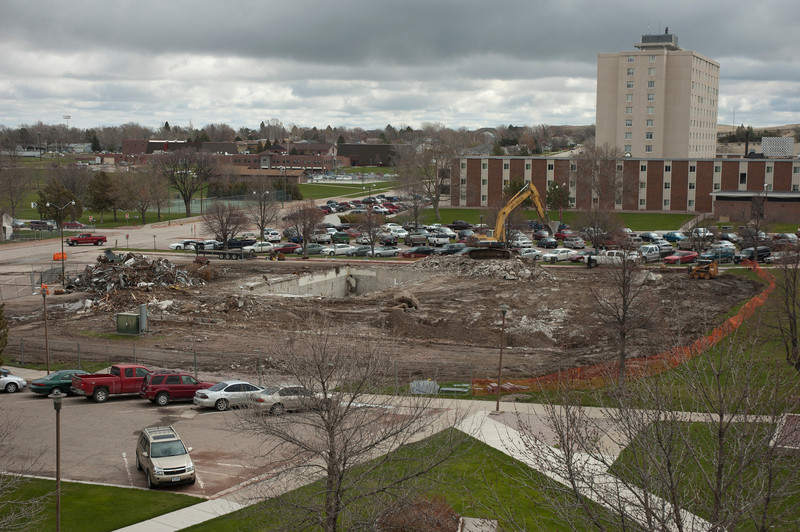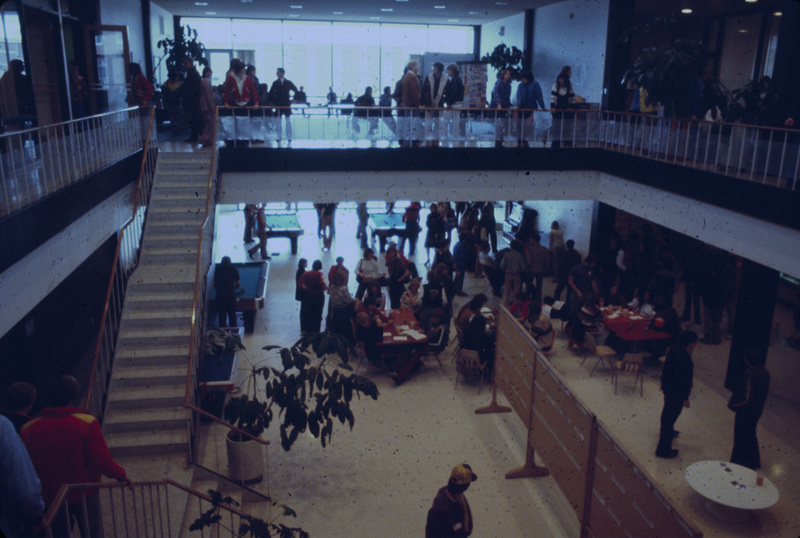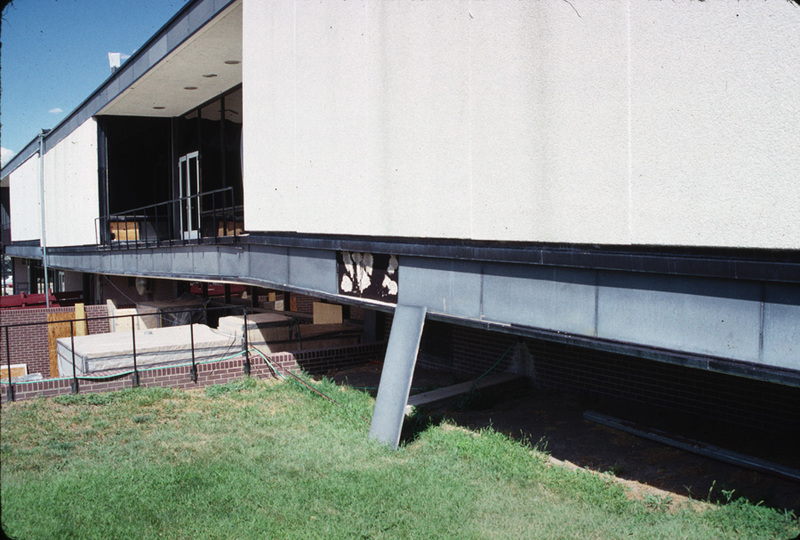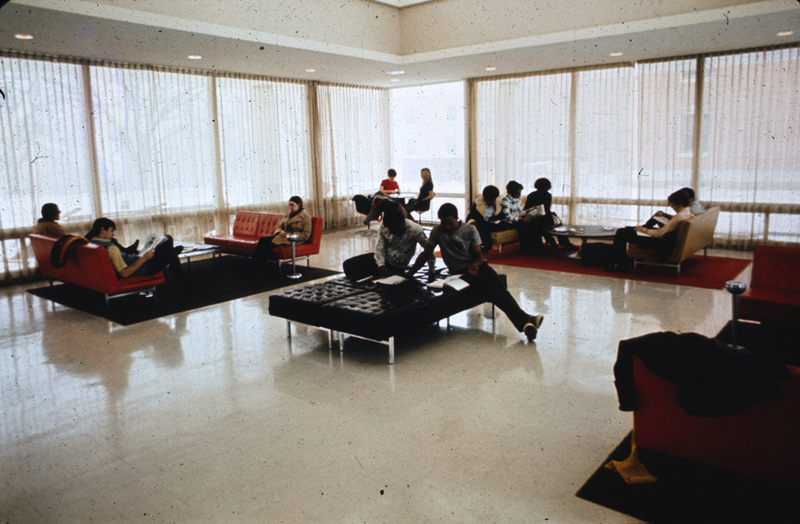Remembering Kline

First dates, winter balls, the Phantom. As the brick and beams came down, the memories flowed on for the Kline Center, which was demolished during the past month. The Kline experience, from 1961-2010, spanned at least two campus generations.
See also: Kline Center Photo Gallery
Those who remember the original building, with both the north and south sides intact, talk of the grace and elegance that Kline possessed.
“It had a regal air,” said Deb Meter, CSC coordinator of cooperative education and a 1972 graduate.
The south side, closed in 1979 due to settlement, was demolished in 1987. College officials, led by President Edwin Nelson, tried to save the facility that had been the “campus center,” but studies determined it would be too costly to restore.
The south side featured panoramic views from the 12-foot windows and a second-floor balcony that framed a bird's eye view of the activity below. The cafeteria was also upstairs, near the west and east-side lounges.
Twin Stairways linked the balcony with the first floor, and were often used as backdrops for coronations in the early years.
The first floor also had a four-lane bowling alley tucked in the southwest corner and a open area with the snack bar and pool tables. Things flowed on the first floor, from snacks, to pool to conversation.
The north side, completed five years after the south side opened, had a ball room, conference rooms and book store. It had the same elegance while being functional.
As a social center, Kline was the gathering place, said Denise Donohue Wickham (1970). “It was the place to see and be seen,” she said.
Agnes Chase Cortney (1970) will always link Kline with her wedding: “I had my reception there.”
Joyce Serbousek Clippinger (1976), started her day at Kline before classes. Serbousek worked in the cafeteria from 6-9 a.m., peeling 20 pounds of carrots with the cooks as the sun rose. "I am still a morning person."
There was always a big morning rush of coffee drinkers, said Teresa Chase Nelson (1971), who worked in the snack bar.
Another surge of students came in the mid-afternoon, right before the TV drama Dark Shadows, Nelson said. “They would get their snacks and then flock to the TV there,” she said.
The homemade baked goods were usually gone by the first coffee break, said Nelson, who remembers guest speakers stopping in for the cream pies.
Hamburgers and shakes were another big item, Nelson said. There was the night a fraternity pledge ordered a milkshake, hoping he could down more goldfish at some nearby contest, she said. “He'd already swallowed 40 fish.”
Hanging out in Kline was a campus-life staple, said Jeanie Neese Sedivy, a student in the mid-'70s. “I had my first date with Warren there at a Homecoming dance.”
The upstairs lounge, bowling alley and pool tables all offered every day breaks, she said.
Bowling didn't cost more than 50 cents, said Warren Sedivy. Along with a couple of burritos from the snack bar it was a cheap afternoon. “I never saw a bowling alley that small,” he said. “But it was a bargain.”
Sedivy bowled with classmate Craig Manley in 1978, but didn't notice any cracks in the foundation, he said. “My game wouldn't have been affected. The ball always found the gutter anyway.”
The formal and playful resided in Kline. Connie McCrae Krezelok (1971) remembers a food fight one day. “It was mashed potatoes as I recall. Someone flicked a spoonful and it began. We laughed and flicked for what seems a long time,” said Krezelok. “I think we helped clean it up when it was all done.”
Con Marshall, CSC information director from 1969-2005, got to experience the original Kline both as a student and staff.
“That place was packed with people,” Marshall said. “Students and faculty would have coffee between classes. There was a lot of interaction between the two groups,” he said.
Bruce Huckfeldt, CSC print shop supervisor, took advantage of the campus coffee break. “There were no classes at 10 a.m. on Tuesday and Thursday mornings so we all gathered for the coffee klatch,” said Huckfeldt, a 1984 graduate. “It was always jammed pack at that time. I got to know every one of my professors in biology -- Dr. Gibson, Druecker, Weedon during that time.”
The fact that the administration put a high priority on the coffee break boosted turnout, said Del Hussey, retired financial aid director.
"It wasn't mandatory, just close to it. But you looked forward to it so much that it didn't have to be a requirement.”
Homemade cinnamon rolls, made by a cook at 4 every morning, were Hussey's snack of choice before heading upstairs to the faculty lounge, he said. "Most of the time I never made it upstairs because we'd stop at a table to talk to students or faculty or staff. It was a family-type atmosphere."
The coffee break created relationships you wouldn't otherwise have, Hussey said.
Even the Phantom, a campus legend dressed in bandages, trench coat, fedora and shades, made an appearance at the Kline Campus Center, Marshall said.
“The Phantom showed up standing on the balcony, above the crowd below. Some guys chased the Phantom all the way to the canyon and caught him, but they didn't reveal the identity.”
As a cultural center, Kline's reach went beyond the campus. Concerts and high school dances linked Kline to the community and region.
The Mitchell Trio, with a young John Denver, performed at Kline. So did Mac Davis, George Carlin, Helen Reddy and the Grass Roots. The concerts were sponsored by Campus Activities Board but were open to the public.
Packed banquets were common, said Marshall. “Coach Bob Devaney was one of the guest speakers one year and we ran out of food,” he said. Olympians Jesse Owens and Rafer Johnson also spoke at conferences in Kline in the early '70s.
The Scholastic Contest brought droves of area high school students through Kline, where test scores were posted on the first floor.
“I remember looking down from the balcony into the big open hole -- it was super crowded,” said Dewayne Gimeson, CSC public information specialist. Gimeson, a 1984 graduate, was a high school contestant in 1978 while attending Grant High School.
“We heard there was food there but it was so full we didn't wait,” he said. “I think we were more interested in what was going on in the buses.”
Like the soil beneath it, Kline's function and personality shifted a bit when the south side closed.
Gone were the stairway coronations and the cafeteria was temporarily moved to the National Guard Armory.
No bowling alley on the north side, but more offices. The book store remained in the basement until the new campus center was erected in the mid-1990s.
Marshall saw the dynamics change. “When it (south side) closed the interaction between the students and faculty changed. We lost some of the interaction, especially when the cafeteria was moved to the armory.”
The change in attitude might have come anyway, said Hussey.
"What killed it (coffee hour) was the emergence of coffee lounges in the new buildings on campus. President Nelson fought it but individual coffee pots won out.”
A new generation of students then passed through the north doors, and Kline's unique hanging lights still adorned the entry, a link to its former self.
“I stood on the steps of Kline waiting for my ACT test in 1979,” said Tena Cook, director of admissions and a 1992 graduate. “I remember those lights that looked like planets -- so Jetson-esque.”
She said one endearing feature of Kline was the string that hung from third floor to the basement, with a clasp on it.
The string served as a way of sending documents to the basement office, where the Information Office was located. “Kind of like reeling in fish,” Cook said.
The alumni office, on the top floor, started the practice, Marshall said. “I used it a lot -- it saved me walking down two flights of stairs. You can't send everything in an email.”
Rosella Tesch (1998) never saw the south side of Kline but felt the north side had its own vitality, both from the people who worked there and the design.
"When I first enrolled I noticed how distinctive Kline was from the other buildings," she said. "It was light, open and had positive energy. It had good vibes."
Tesch had good memories from her visits in Kline, where she used the support services, she said.
Both the Eagle newspaper and the tutoring services also occupied part of the top floor of Kline's north side in the '90s.
Pizza and deadlines always went together at the Eagle, said Daniel Binkard, CSC graphic design artist.
“We often stayed until midnight before finishing up Thursday morning,” he said. Binkard worked on the Eagle in 2004-2007 and remembers the last days of the dark room era while working in Kline. “There were few sinks in Kline but we had one of them.”
There weren't any cots in Kline either but students were resourceful, said LaVida Dickinson, the Eagle adviser for most of the Kline tenure.
“There was one student who brought her pillow and took short naps under the table Thursday mornings if she happened to stay out too late Wednesday night (not to do Eagle production either).”
The Eagle in Kline had its own character, Binkard said. He noted that the newsroom walls were covered with notes and style references, and a glass witch bowl hung from the center of the ceiling.
The bowl was made in the glass-blowing lab by an editor who learned that witch balls were hung in studios to absorb negative spirits, Dickinson said.
A bad night would prompt someone to call for a new ball, Binkard said.
The west-side balcony near the newsroom was a plus, Dickinson said. “Smokers loved having the balcony, and we joked about serving mint juleps there on hot afternoons.”
Laughter often could be heard echoing down the halls from the alumni office, said Binkard. “It was always a welcoming environment for me.”
Frances Gonzalez, CSC tutoring services counselor, had her first experience in Kline's north side as a student, at an honors dinner hosted by President Sam Rankin. “It was in the ball room and we brought our parents. That recognition meant a lot.”
The Learning Center occupied part of the ball room for 17 years. “It was our home -- tutoring, supplemental instruction and the International Club all used it.” Graduation receptions and recognition parties took place there, said Gonzalez.
Pot lucks for all the staff in the building were a monthly affair: “the print shop, conferencing, alumni all joined in. It was a neat place to do those things.”
Nick Brening, May graduate, served as a tutor and supplemental instructor for three years in Kline and was sad to see it go, he said. “It was such a nice space, with the high ceiling and all that light in there,” he said. The center had the right atmosphere for learning, Brening said. “I used the tutoring services myself as a freshman.”
Kline's contribution to the campus might best be framed by those students who remember the pre-Kline days.
Bruce Shaver (1963) was a sophomore when Kline opened.
“Prior to Kline we had the student center in the north side of the Memorial Hall and the cafeteria in the south side–Kline was way more than we expected. There wasn't anything like it in western Nebraska.”
Shaver spent his share of time there. “It was where all the action was,” he said.
Judy Nelson (1964) was glad she got to experience Kline in its heyday. “It was a state of the art building,” said Nelson, daughter of the former president. Images of the Eaglaires performing in Kline's elegance stay with her, she said.
Her dad took all personal guests there for lunch when they visited, Judy said.
The Lindeken Clock Tower anchors the new student center, and Tesch sees the shift in eras.
Kline represented a confidence and optimism that ushered in the '60s. The new center is more modest, practical, she said.
Jeanie Sedivy still remembers the effect Kline had on her when she attended the freshman orientation.
“I walked in there with my freshman beanie on, looked around and thought 'I am big-time now.'”
Category: Campus News




